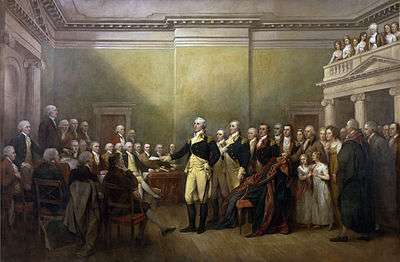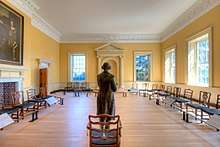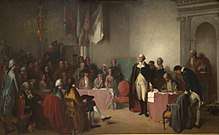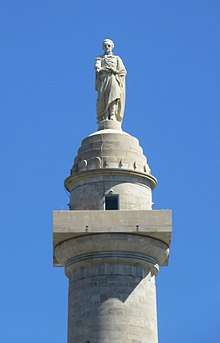George Washington's resignation as commander-in-chief
 | |
| Date | December 23, 1783 |
|---|---|
| Venue | Maryland State House |
| Location | Annapolis, Maryland |
| Coordinates | 38°58′43″N 76°29′28″W / 38.97861°N 76.49111°WCoordinates: 38°58′43″N 76°29′28″W / 38.97861°N 76.49111°W |
George Washington's resignation as commander-in-chief marked the end of Washington's military service in the American Revolutionary War and his return to civilian life at Mount Vernon. His voluntary action has been described as "one of the nation's great acts of statesmanship" and helped establish the precedent of civilian control of the military.[1] After the Treaty of Paris ending the war had been signed on September 3, 1783, and after the last British troops left New York City on November 25, Washington resigned his commission as commander-in-chief of the Continental Army to the Congress of the Confederation, then meeting in the Maryland State House at Annapolis, Maryland, on December 23 of the same year.[1][2][3] This followed his farewell to the Continental Army, November 2 at Rockingham near Princeton, New Jersey,[4] and his farewell to his officers, December 4 at Fraunces Tavern in New York City.[5]
History
Washington arrived at Annapolis on December 19, 1783, and was greeted by General William Smallwood and General Horatio Gates at the Three Mile Oak.[1][6] The next day, he wrote to Congress about the method to resign, whether in person or by writing. The President of the Continental Congress, Thomas Mifflin, appointed a committee of Thomas Jefferson, James McHenry, and Elbridge Gerry to determine the details.[2][7] On Monday, December 22, Congress honored Washington with a feast at Mann's Tavern, attended by between two and three hundred gentlemen.[7] Later that night, a public ball was held in his honor by Maryland Governor William Paca at the State House. Nearly six hundred guests attended.[8] Historian Willard Sterne Randall describes the evening: "George Washington, a famous dancer, astonished French officers with his skill and grace at the minuet."[7]
At noon, on Tuesday, December 23, Charles Thomson, secretary of the Continental Congress, led Washington, accompanied by two of his aides-de-camp, Col. David Humphreys and Col. Benjamin Walker, into the Senate Chamber of the Maryland State House.[9] While depicted in some paintings of the event, Martha Washington was not actually in attendance.[9] Then Washington delivered his remarks to the assembly:
Happy in the confirmation of our Independence and Sovereignty, and pleased with the opportunity afforded the United States of becoming a respectable Nation, I resign with satisfaction the Appointment I accepted with diffidence.
…
I consider it an indispensable duty to close this last solemn act of my Official life, by commending the Interests of our dearest Country to the protection of Almighty God, and those who have the superintendence of them, to his holy keeping.— George Washington[10]
As the last act of his resignation, Washington handed his commission and his speech to President Mifflin.[7] The next day, December 24, Washington left for Mount Vernon.[3]
Legacy
Historian Gordon S. Wood, the recipient of the 1993 Pulitzer Prize for History for The Radicalism of the American Revolution (1992), writes in his book:[11]
George Washington, of course, was the perfect Cincinnatus, the Roman patriot that returned to his farm after his victories in war. ... The greatest act of his life, the one that gave him his greatest fame, was his resignation as commander in chief of the American forces.
On May 3, 1797, King George III told the American painter Benjamin West his opinion of Washington (as reported by West to ambassador Rufus King):[12]
In regard to General Washington, he told him since his resignation that in his opinion "that act closing and finishing what had gone before and viewed in connection with it, place him in a light the most distinguished of any man living, and that he thought him the greatest character of the age."
The American artist, John Trumbull, in describing his painting, General George Washington Resigning His Commission, considered Washington's resignation "one of the highest moral lessons ever given to the world".[13]
Gallery
 View in 2015 of Old Senate Chamber
View in 2015 of Old Senate Chamber Washington Resigning His Commission by Edwin White, 1858
Washington Resigning His Commission by Edwin White, 1858 Washington Resigning His Commission by Ferdinand Pettrich, c. 1841
Washington Resigning His Commission by Ferdinand Pettrich, c. 1841 George Washington resigning his commission atop the Washington Monument in Baltimore by Enrico Causici, 1829
George Washington resigning his commission atop the Washington Monument in Baltimore by Enrico Causici, 1829 Washington Surrendering His Commission by Edwin Blashfield, 1903
Washington Surrendering His Commission by Edwin Blashfield, 1903
See also

- Lucius Quinctius Cincinnatus
- Newburgh Conspiracy
References
- 1 2 3 "General George Washington Resigned his Commission in Annapolis, Maryland. December 23, 1783". Historian of the United States House of Representatives. Archived from the original on July 27, 2017.
- 1 2 Hillman, Joseph. "Resignation of Military Commission". Mount Vernon Ladies' Association. Archived from the original on 2017-06-30.
- 1 2 "Today in History – December 23: Washington Resigns His Commission". Library of Congress. Archived from the original on 2017-12-23.
- ↑ "George Washington to Continental Army: Farewell Orders, November 2, 1783". Library of Congress. Archived from the original on August 2, 2017.
- ↑ "Today in History – December 4: Goodbye to General Washington". Library of Congress. Archived from the original on 2017-12-20.
- ↑ "George Washington's Resignation Speech: Washington in Annapolis" (PDF). Friends of the Maryland State Archives. January 2017. Archived (PDF) from the original on 2017-03-09.
- 1 2 3 4 Randall, Willard Sterne (1998). George Washington: A Life. pp. 405–8. ISBN 978-0-805-05992-2. Archived from the original on 2018-02-20.
- ↑ Washington, George (1931). "Address to Congress on Resigning His Commission. Footnote 68.". In Fitzpatrick, John C. The Writings of George Washington from the Original Manuscript Sources, 1745–1799. 27. United States George Washington Bicentennial Commission. pp. 285–6.
- 1 2 "Attendees at George Washington's Resignation of his Commission Old Senate Chamber, Maryland State House, December 23, 1783" (PDF). Maryland State Archives. February 2009. Archived (PDF) from the original on April 29, 2017.
- ↑ Washington, George (December 23, 1783). "Washington's Address to Congress Resigning his Commission". Founders Online, National Archives. Archived from the original on January 13, 2018.
- ↑ Wood, Gordon S. (1992). The Radicalism of the American Revolution. Vintage Books. p. 205. ISBN 978-0-679-73688-2. Archived from the original on 2018-02-20.
- ↑ Clark, Harrison (1996). All Cloudless Glory: The Life of George Washington : Making a Nation. pp. 349–350. ISBN 978-0-895-26445-9. Archived from the original on 2018-02-20.
- ↑ Trumbull, John (1841). Autobiography, Reminiscences and Letters of John Trumbull, from 1756 to 1841. New York: Wiley and Putnam. p. 263. Archived from the original on 2018-02-19.